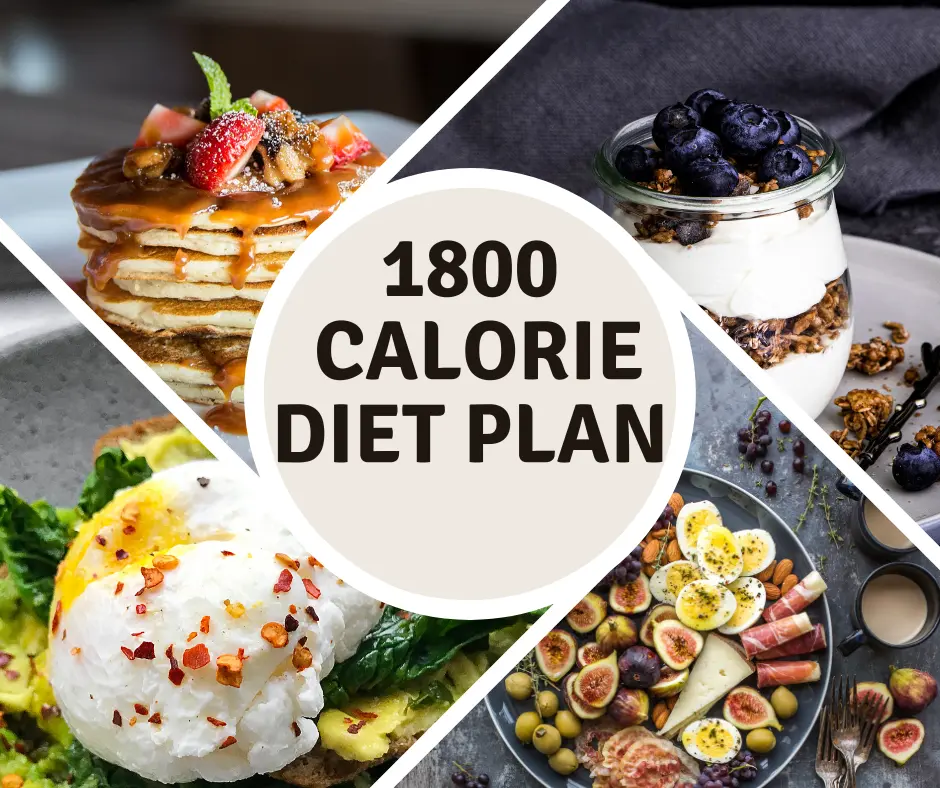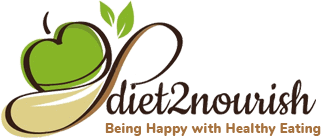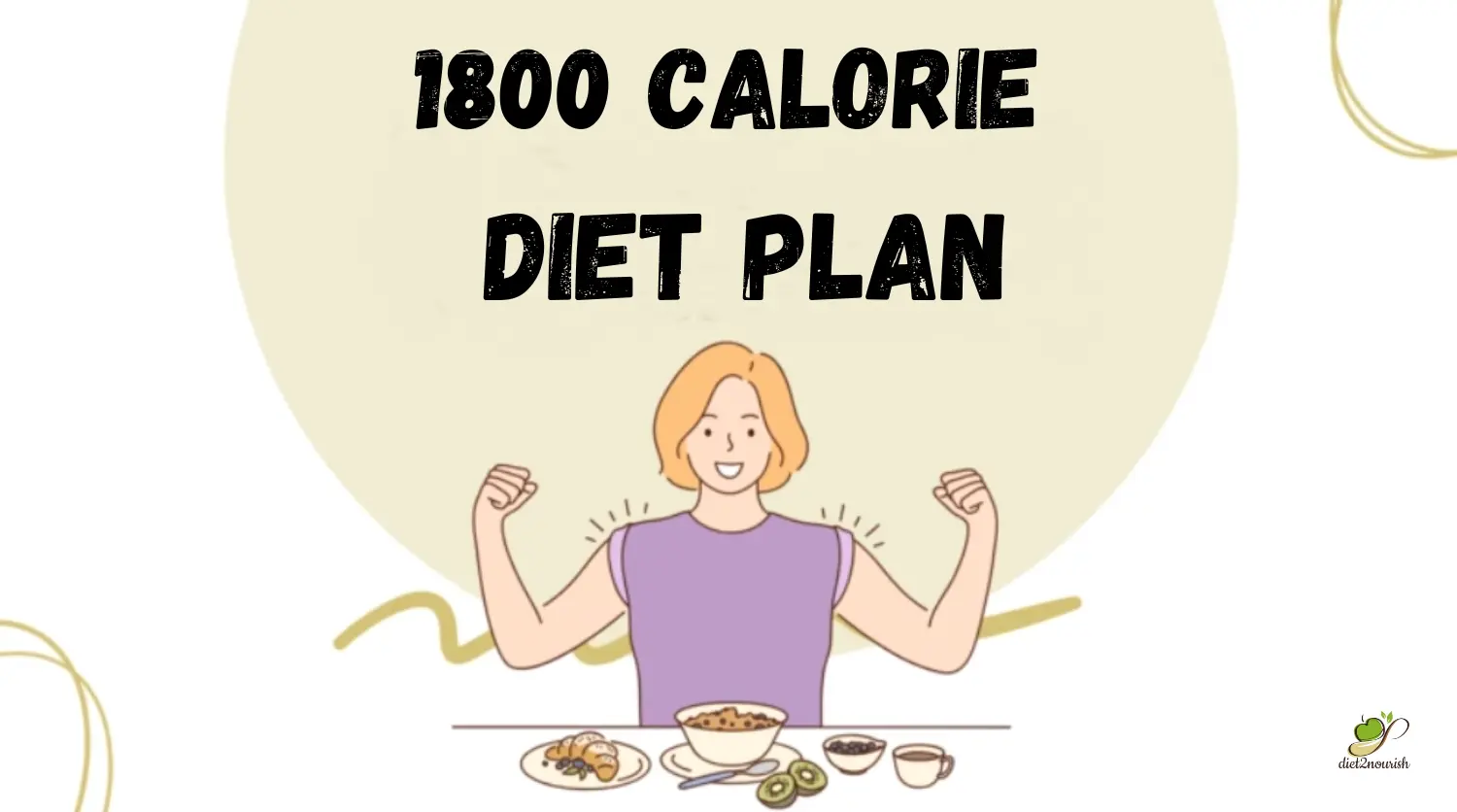1800 Calorie Diet Plan
Many people want to reduce or balance their weight with great effort and also wish to maintain that weight forever. That’s why he follows some type of diet, one of which is the 1800 Calorie Diet Plan. This diet mainly includes those foods which are necessary to provide a nutritious and balanced diet to a person. This blog consists of a well-researched 1800 calorie diet plan that will help you become a healthy lifestyle part of your life.
Why is the 1800 Calorie Diet Plan to added to stay healthy and fit?
The 1,800-calorie diet plan allows one extra snack and slightly more starch than lower-calorie diet plans to meet the body’s needs for protein and carbohydrates. When comparing diet plans for 1200 or 1600 calories, it can be seen that the menus are pretty similar in terms of food items. But as calories go up, try increasing the number of servings from different food groups during the day.
Benefits of 1800 Calorie Diet Plan are as follows:
- For most women to maintain their weight and the majority of men to lose weight, sticking to 1,800 calories per day is frequently advised.
- In light of this, selecting foods high in fiber, lean protein, and healthy fats ensures you’ll have a filling day without consuming excessive calories.
- By sticking to an 1800 calorie diet, you can lose one pound each week while also getting the right amount of exercise.
- The 1800 calorie diet plan Indian is considered a low-fat, moderate-protein, and carbohydrate diet. Anyone with a healthy weight and an active lifestyle can follow the 1800 calorie diet plan.
How to Plan a Meal on a Diet of 1,800 Calories?
Prepare your meals in advance:
A huge time saver during hectic weeks is setting aside time on a Sunday or your day off to plan your meals for the week, grocery shopping, and prepare some meals in advance. Additionally, it helps you keep on schedule and might lessen stress while deciding what to eat.
Start the day off with a healthy breakfast:
To give you energy and keep you satisfied until lunch, make sure your breakfast has a lot of protein, good fats, and fiber.
Be mindful of the timing:
Consider distributing meals and snacks so that one takes place every three to four hours. Timing shouldn’t be overlooked; you should consider distributing meals and snacks that happen around every 3 to 4 hours. As a result, you don’t become too hungry, and your energy levels stay high throughout the day.
Be mindful of your food groupings:
Finding food to eat every day might be difficult. Consider including fruit or vegetable, protein, carbohydrate, and fat at each meal to make it simpler. You may obtain all the nutrients from this combo, which also helps you feel full and pleased.
A short-term 1800 calorie diet plan:
Your diet plan must be practical and long-term if you want to lose weight slowly and sustainably.
What can you include in an 1800 calorie diet Plan?
1. Protein Food:
You can include fish, poultry, lean meat, seafood, nuts, etc., in this category.
2. Dairy Food:
You should consume more milk, curd, and other dairy products.
3. Vegetables:
Under this diet, you can eat green leafy vegetables and include some starchy vegetables, like sweet potatoes, etc., in your diet. Additionally, vegetables of different colors, like bell pepper, carrot, radish, brinjal, etc., can also be eaten.
4. Fruit:
Instead of making fruit juice and drinking it, you should eat fruits as such. In fruits, you can include berries, apples, potato fever, and citrus fruits in your diet.
5. Egg whites and lean meat:
Non-vegetarian meals are a good source of protein. These aid in calorie burning and good weight maintenance. Organ meats should be avoided as they are high in saturated fats. Choose fish, chicken, or egg whites.
6. Beans and lentils:
Protein content is enhanced when combined with grains. These have a high satiating impact because they are also high in fiber. Include beans and lentils in dishes by adding them as dals, sprouts, khichdi, or dal flour.
7. Whole-grain cereals contain complex carbs:
Whole grain or multigrain bread or flour, oats, quinoa, daliya, millets, and so on. Complex carbs have a low glycaemic index and a high fiber content.
8. Nuts:
Nuts are full of fiber, nutrients, and minerals. Walnuts, which are high in omega 3, are a better choice than cashews, which are high in saturated fat.
9. Healthy Fats and Oils:
Use of some fat or oil like avocado, olive, or olive oil can be included in your diet. There are healthful 1800 calorie diet plan options to be considered.
A well calculated 7-days 1800 Calorie Diet Plan

Here’s a 7-day 1800 calorie diet plan with the approximate calorie count:
Day 1:
- Breakfast:
1 cup of oatmeal with 1/2 cup of sliced strawberries and 1 tablespoon of honey, 1 small banana, 1 cup of low-fat milk (470 calories)
- Snack:
1 apple, 1 small handful of almonds (200 calories)
- Lunch:
2 slices of whole-grain bread, 3 oz of turkey breast, 1 slice of low-fat cheese, 1 tablespoon of mayonnaise, 1 cup of baby carrots, 2 tablespoons of hummus (460 calories)
- Snack:
1 small container of low-fat Greek yoghourt, 1/2 cup of blueberries (130 calories)
- Dinner:
4 oz of grilled chicken breast, 1/2 cup of brown rice, 1 cup of steamed broccoli, 1 small side salad with mixed greens, cherry tomatoes, cucumber, and 2 tablespoons of balsamic vinaigrette (440 calories)
- Snack:
1 small peach, 1 small handful of walnuts (200 calories)
Day 2:
- Breakfast:
2 scrambled eggs, 1 slice of whole-grain toast, 1/2 cup of sliced avocado, 1 cup of low-fat milk (430 calories)
- Snack:
1 small orange, 1 small handful of cashews (240 calories)
- Lunch:
2 cups of mixed greens, 3 oz of grilled salmon, 1/4 cup of crumbled feta cheese, 1/4 cup of sliced red onions, 2 tablespoons of balsamic vinaigrette (450 calories)
- Snack:
1 small container of low-fat Greek yoghourt, 1/2 cup of sliced peaches (130 calories)
- Dinner:
4 oz of grilled sirloin steak, 1/2 cup of roasted sweet potatoes, 1 cup of steamed green beans, 1 small side salad with mixed greens, cherry tomatoes, cucumber, and 2 tablespoons of Italian dressing (450 calories)
- Snack:
1 small apple, 1 small handful of almonds (200 calories)
Day 3:
- Breakfast:
1 whole-grain English muffin, 2 scrambled eggs, 1 slice of low-fat cheese, 1 small orange, 1 cup of low-fat milk (430 calories)
- Snack:
1 small container of low-fat cottage cheese, 1/2 cup of sliced cucumbers (130 calories)
- Lunch:
2 slices of whole-grain bread, 3 oz of grilled chicken breast, 1/4 avocado, 1 cup of cherry tomatoes, 2 tablespoons of balsamic vinaigrette (450 calories)
- Snack:
1 small container of low-fat Greek yoghourt, 1/2 cup of sliced strawberries (130 calories)
- Dinner:
4 oz of grilled shrimp, 1/2 cup of quinoa, 1 cup of roasted asparagus, 1 small side salad with mixed greens, cherry tomatoes, cucumber, and 2 tablespoons of Italian dressing (450 calories)
- Snack:
1 small pear, 1 small handful of walnuts (200 calories)
Day 4:
- Breakfast:
1 whole-grain English muffin, 2 scrambled eggs, 1 slice of low-fat cheese, 1 small banana, 1 cup of low-fat milk (430 calories)
- Snack:
1 small container of low-fat cottage cheese, 1/2 cup of sliced carrots (130 calories)
- Lunch:
2 slices of whole-grain bread, 3 oz of roasted turkey breast, 1/4 avocado, 1 cup of cherry tomatoes, 2 tablespoons of hummus (450 calories)
- Snack:
1 small container of low-fat Greek yogurt, 1/2 cup of sliced peaches (130 calories)
- Dinner:
4 oz of baked salmon, 1/2 cup of quinoa, 1 cup of steamed broccoli, 1 small side salad with mixed greens, cherry tomatoes, cucumber, and 2 tablespoons of balsamic vinaigrette (450 calories)
- Snack:
1 small apple, 1 small handful of cashews (200 calories)
Day 5:
- Breakfast:
1 cup of low-fat cottage cheese, 1/2 cup of sliced peaches, 1 small whole-grain muffin, 1 cup of low-fat milk (430 calories)
- Snack:
1 small orange, 1 small handful of almonds (240 calories)
- Lunch:
2 slices of whole-grain bread, 3 oz of grilled chicken breast, 1 slice of low-fat cheese, 1 tablespoon of mayonnaise, 1 cup of baby carrots, 2 tablespoons of hummus (460 calories)
- Snack:
1 small container of low-fat Greek yoghourt, 1/2 cup of blueberries (130 calories)
- Dinner:
4 oz of baked tilapia, 1/2 cup of brown rice, 1 cup of roasted Brussels sprouts, 1 small side salad with mixed greens, cherry tomatoes, cucumber, and 2 tablespoons of Italian dressing (450 calories)
- Snack:
1 small banana, 1 small handful of pistachios (200 calories)
Day 6:
- Breakfast:
1 whole-grain English muffin, 2 scrambled eggs, 1 small apple, 1 cup of low-fat milk (430 calories)
- Snack:
1 small container of low-fat cottage cheese, 1/2 cup of sliced bell peppers (130 calories)
– Lunch: 2 slices of whole-grain bread, 3 oz of roasted turkey breast, 1/4 avocado, 1 cup of cherry tomatoes, 2 tablespoons of mustard (450 calories)
- Snack:
1 small container of low-fat Greek yogurt, 1/2 cup of sliced mango (130 calories)
- Dinner:
4 oz of grilled chicken breast, 1/2 cup of brown rice, 1 cup of roasted sweet potatoes, 1 small side salad with mixed greens, cherry tomatoes, cucumber, and 2 tablespoons of balsamic vinaigrette (450 calories)
- Snack:
1 small pear, 1 small handful of almonds (200 calories)
Day 7:
- Breakfast:
1 cup of low-fat Greek yogurt, 1/2 cup of sliced strawberries, 1 small whole-grain muffin, 1 cup of low-fat milk (430 calories)
- Snack:
1 small container of low-fat cottage cheese, 1/2 cup of sliced zucchini (130 calories)
- Lunch:
2 slices of whole-grain bread, 3 oz of grilled chicken breast, 1 slice of low-fat cheese, 1 tablespoon of mayonnaise, 1 cup of baby carrots, 2 tablespoons of ranch dressing (460 calories)
- Snack:
1 small container of low-fat Greek yoghourt, 1/2 cup of sliced kiwi (130 calories)
- Dinner:
4 oz of baked salmon, 1/2 cup of brown rice, 1 cup of steamed green beans, 1 small side salad with mixed greens, cherry tomatoes, cucumber, and 2 tablespoons of Italian dressing (450 calories)
- Snack:
1 small apple, 1 small handful of cashews (200 calories)
What to Avoid During 1800 Calorie Diet Chart?
1. Salt
Excess salt is not suitable for your health, so limit its quantity.
2. Added Sugar
Sugar not only increases your obesity and calorie intake, but it also brings with it many diseases. That’s why it should be consumed, at least.
3. Trans Fat
Trans fat is included chiefly in junk food like burgers, pizza, etc., and you should not eat it.
4. Alcohol
If you cannot live without alcohol, you should do it in limited quantity. But if you drink occasionally, you should stop altogether.
5. A high amount of saturated fat
This fat harms your body as it increases your blood pressure and cholesterol level. Due to this, you are also at risk of heart disease.
If you follow this type of calorie diet, then you can move towards a healthy lifestyle, and your weight can also remain as much as you want. But for this, you must follow this calorie diet strictly, and once a week, you can also have a cheat day.
Following are a few tips to keep in mind to get the maximum result out of the 1800 Calorie Diet Plan
- Consume Good Fats to Lose Weight
- Eat two to three hours before bed.
- Make wholesome changes
- Adhere to Smart Dining Advice
These Don’t should be eliminated from your life to stay healthy
- Avoid starving yourself.
- Do not become dehydrated.
- If you are not hungry, do not eat.
- Limit your intake of saturated fat.
The Bottomline
An optimistic attitude toward life results from adjusting to a healthy lifestyle modification. Maintaining your health and fitness requires a diet low in calories and enough exercise. With an 1800 calorie diet plan, you will receive all the nutritional benefits in full, without any deficiencies.
Frequently asked questions ( FAQs)
How can I make sure I’m getting enough protein on an 1800 calorie diet?
Answer:
You can make sure that you’re getting enough protein while being on an 1800 calorie diet by including sources of lean proteins. You can include chicken, fish, tofu, and beans in your meals and can help you reach your daily protein needs. Moreover, you can also supplement with protein shakes or bars if needed.
What kind of snacks can I eat on an 1800 calorie diet?
Answer:
Some of the best healthy snack ideas for an 1800 calorie diet include fruit slices with almond butter, Greek yoghurt with berries, Hard-boiled eggs, Roasted chickpeas, Air-popped popcorn and dried fruit. You can consume them without disturbing your nutrient intake. Remember to keep your portions in check and make sure your snacks fit within your daily calorie limit.
Should I avoid carbs on an 1800 calorie diet?
Answer:
No, you don’t need to avoid carbs on an 1800 calorie diet. However, it’s a good idea to choose complex carbs. You can find them in whole grains, fruits, and vegetables. Moreover, it is better to avoid simple carbs like those found in sugary drinks and snacks.









